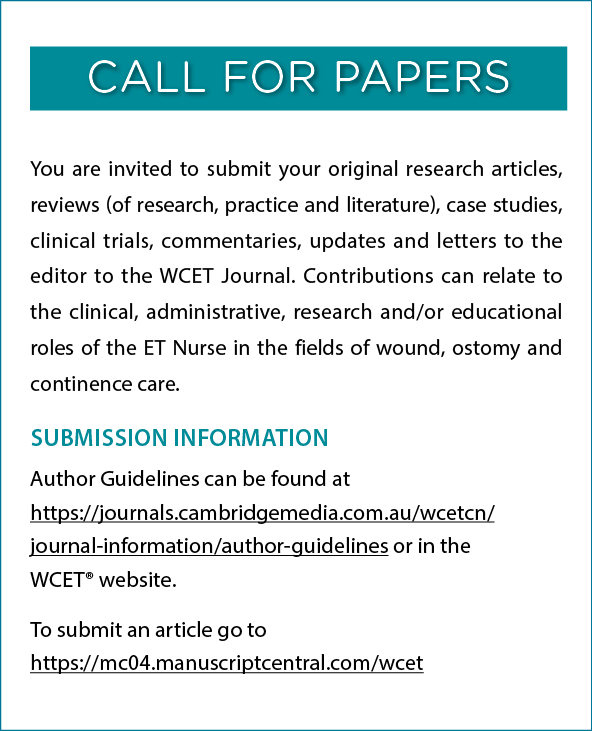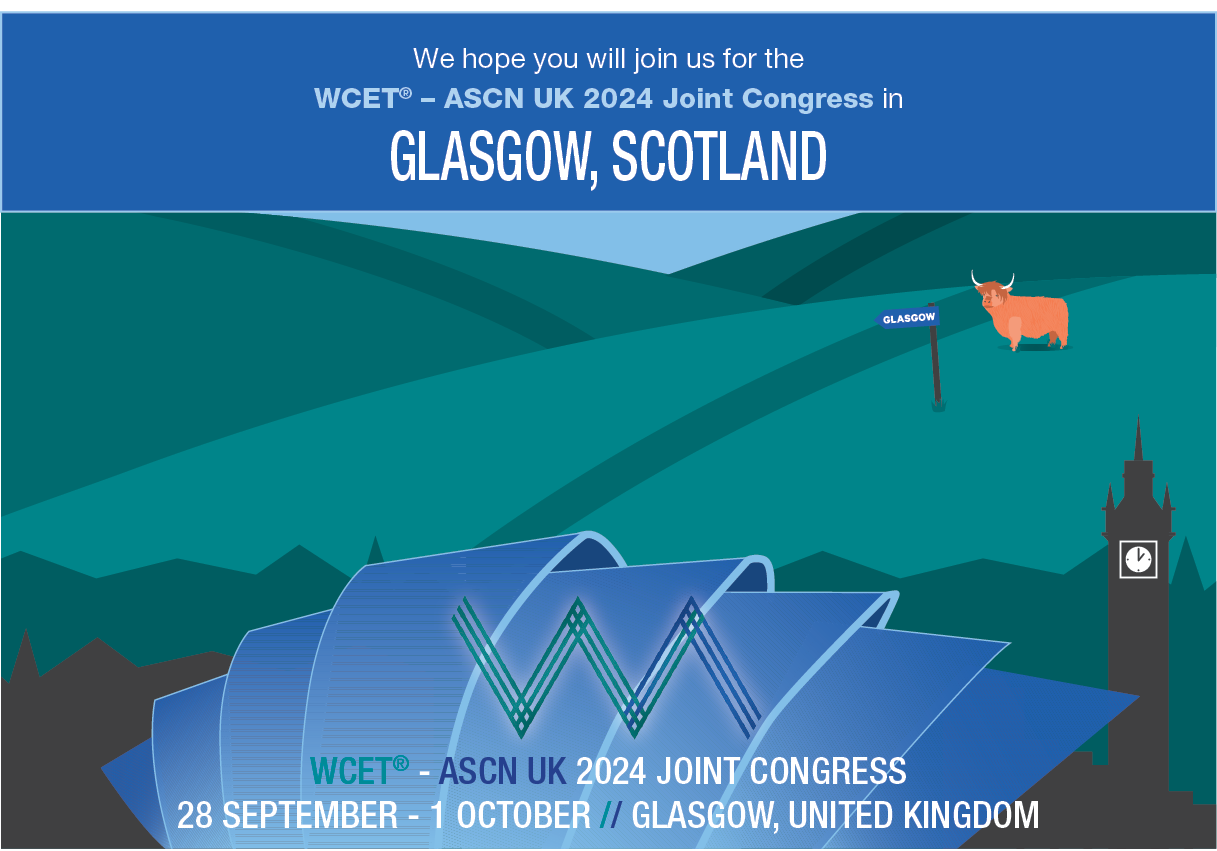Volume 42 Number 2
Bespoke approaches to wound management
Jenny Prentice
For referencing Prentice J. Bespoke approaches to wound management. WCET® Journal 2022;42(2):7
DOI https://doi.org/10.33235/wcet.42.2.7
Different situations often require a bespoke approach or service to address an underlying issue.
The contents of this issue, in conjunction with the Journal Supplement, highlight a variety of clinical, educational and experimental research issues with authors offering bespoke solutions.
Within the Congress Supplement, Plate identifies in his Editorial the importance of “tailoring ostomy care” to meet the needs of and improve quality of life for people with stomas. Colwell goes on to further discuss the importance of peristomal skin protection and the critical factors of correctly assessing the size and shape of the stoma when considering an appropriate pouching system to ensure an effective seal to prevent leakages. Hansen and colleagues define the term ‘peristomal body profile’ and describe how a modified Delphi approach was used to engage stomal therapy nurses’ opinions to form consensus statements on peristomal body profiling and the use of convexity post-operatively. We are most appreciative of Coloplast’s support of the WECT® in providing this supplementary information.
Hiske Smarte, incoming president of the International Interprofessional Wound Care Group (IIWCG) discusses how the IIWCG adopted a hybrid approach to host the World Union of Wound Healing Society’s Conference in Abu Dhabi in March 2022, thereby overcoming the challenges and stressors presented by the COVID-19 pandemic. These strategies ensured attending and virtual delegates reaped the benefits of all speakers’ advice.
Similarly in the President and President Elects message, emulation of such strategies to facilitate hosting of the joint WCET® / WOCN Congress in Fort Worth, Texas is alluded to.
Orlov et al, within their article ‘Fluid handling dynamics and durability of silver-containing gelling fibre dressings tested in a robotic wound system’ discuss a novel bespoke approach to simultaneously testing fluid absorbency and retention (sorptivity) and durability properties of two gelling fibre dressings and their interactions with secondary dressings in a simulated wound environment. The importance of clinicians having a greater understanding of these dressing properties within both the primary and secondary dressings as evaluated and to assist with clinical decision-making are explained.
Questionnaires are an often-used method to obtain clinical information. Well-designed questionnaires assist investigators to elicit and analyse the information they require to examine, analyse, and propose solutions to ameliorate an issue. Dr John Stephenson, in his second article related to statistics, specifically addresses the use of questionnaires within the arena of wound management. He guides us to reflect on and consider inherent factors prior to and during questionnaire design. These include study sample selection; factors to be studied; formulating and scoring questions asked; how to maximise response rates; and how to refine a questionnaire through pilot processes. Following this advice, the principles of which are applicable to any wound ostomy or continence scenario, means investigators will have a bespoke tool that provides the best opportunity for them to understand the issue under investigation and devise an appropriate response.
Complex chronic wounds in Brazil, it is suggested, are a public health issue with associated financial implications. Consequently a Stomal Therapy Nurse (STN)-led wound management outpatient clinic was established in the Cariri Ceará region of Brazil. Sampaio et al describe the results of a retrospective clinical audit on wound types and wound healing outcomes of patients who presented to the STN-led wound management outpatient clinic for wound care and postulate whether this bespoke service will assist in the prevention and management of community-acquired wounds.
In low-income countries treatment of wounds in a bespoke manner is often by default due to the necessity to use locally available non-expensive materials. Haesler provides a summary of the properties, advantages and disadvantages associated with the use of Aloe vera for treating burn wounds concluding that Aloe vera presents a cost-effective management option.
In concluding this Editorial I would like to acknowledge the recipients of the inaugural WCET® Norma N Gill President’s Award recipients Paula Erwin-Toth, Sally J Gill-Thompson and Dr Diane L Krasner for their life-long and outstanding contributions to the profession.
In addition, and with reference to the five Cs of extraordinary teams (competitors, common goals, communicate, chemistry and consistency) as mentioned with the President and President Elect’s message, I would like to add another ‘C’ - that of ‘Consummate’ professionals with regard to Elizabeth Ayello and Greg Paull. Elizabeth, I understand, has given 19 years of continual service to the WCET® Board. This is an amazing achievement and speaks of dedication to furthering the goals of the WCET® and wound, skin, ostomy and continence care globally using her own powerful collaborative bespoke approach. Greg has provided 26 years of service to the WCET® from a variety of perspectives as identified by Elizabeth and Laurent Chabal. In today’s world of publishing this is extraordinary commitment and demonstration of teamwork.
As Editor, I am indebted to both Elizabeth and Greg for their guidance. I look forward to working with Laurent and his team in the same collegial manner.
With Kind Regards
Jenny
Editor


伤口管理的定制化方法
Jenny Prentice
DOI: https://doi.org/10.33235/wcet.42.2.7
不同的情况通常需要定制的方法或服务以解决潜在问题。
本期内容结合杂志增刊,突出了各种临床、教育和实验研究问题,同时作者提供了定制的解决方案。
在大会增刊中,Plate在其编者按中指出了“量身定制造口护理”的重要性,以满足造口患者的需求并提高其生活质量。Colwell继续进一步讨论了造口周围皮肤保护的重要性,以及在考虑适当的造口袋系统时正确评估造口大小和形状以确保有效密封,从而防止泄漏的关键因素。Hansen及其同事定义了术语“造口周围身体形态”,并描述了如何使用改良的德尔菲法来征求造口治疗护士的意见,从而就造口周围身体形态分析和术后使用凸面装置形成共识陈述。我们非常感谢Coloplast对WECT®的支持以及提供的此补充信息。
国际跨专业伤口护理组(IIWCG)的新任主席Hiske Smarte论述了IIWCG如何采用混合会议方式于2022年3月在阿布扎比主办了世界伤口愈合学会联盟(WUWHS)大会,从而克服了COVID-19大流行带来的挑战和压力。这些策略确保了与会代表和线上代表均能从所有演讲者的建议中获益。
同样,在主席和候任主席的致辞中,也提到了效仿此类策略,以推动在德克萨斯州沃思堡举办WCET®/WOCN联合大会。
Orlov等人在他们的文章《在机器人伤口系统中测试含银凝胶纤维敷料的液体处理动力学和耐久性》中讨论了一种新的定制方法,用于在模拟伤口环境中同时测试两种凝胶纤维敷料的液体吸收性、保留性(吸附性)和耐久性,及其与外层敷料的相互作用。本文解释了临床医生在评价接触性敷料和外层敷料以及协助临床决策时对这些敷料特性有更深入了解的重要性。
问卷调查是获取临床信息的常用方法。精心设计的调查问卷有助于调查人员获取并分析他们所需的信息,以检查、分析并提出改善问题的解决方案。John Stephenson博士在他的第二篇与统计学有关的文章中,特别提到了在伤口管理领域使用问卷调查的问题。他引导我们在设计问卷之前和期间反思并考虑固有的因素。其中包括研究样本的选择;需要研究的因素;所问问题的制定和评分;如何最大限度地提高回复率;以及如何通过试点调查过程完善问卷。遵循这一建议(其原则适用于任何伤口造口或失禁情况)意味着研究者将拥有一个定制工具,为他们提供最佳机会,以了解所调查的问题并制定适当对策。
据悉,在巴西,复杂的慢性伤口是一个具有相关财务影响的公共卫生问题。因此,在巴西的Cariri Ceará地区成立了一家由造口治疗护士(STN)领导的伤口管理门诊。Sampaio等人描述了对前往STN领导的伤口管理门诊进行伤口护理的患者的伤口类型和伤口愈合结果的回顾性临床审核结果,并推测这种定制服务是否会有助于预防和管理社区获得性伤口。
在低收入国家,由于必须使用当地可获得的非昂贵材料,通常默认以定制方式治疗伤口。Haesler总结了与使用芦荟治疗烧伤伤口有关的特性、优势和劣势,并得出结论,芦荟是一种具有成本效益的治疗选择。
在结束这篇编者按时,我想感谢首届WCET®Norma N Gill主席奖的获奖者Paula Erwin Toth、Sally J Gill-Thompson和Diane L Krasner博士,感谢他们对该行业的终身杰出贡献。
此外,参照主席和候任主席致辞中提到的非凡团队的五个“C”[竞争对手(competitors)、共同目标(common goals)、沟通(communicate)、化学反应(chemistry)和一致性(consistency)],我想再补充另一个“C”——关于Elizabeth Ayello和Greg Paull的“完美(consummate)”专业人士。据我所知,Elizabeth已经为WCET®委员会持续服务了19年。这是一项惊人的成就,说明她致力于通过自己强大的协作定制方法,在全球范围内推进WCET®和伤口、皮肤、造口以及失禁护理的目标。Greg从Elizabeth和Laurent Chabal确定的各种角度为WCET®提供了26年的服务。在当今出版界,这是对团队精神的非凡承诺和证明。
作为编辑,我非常感谢Elizabeth和Greg的指导。我期待着以同样的合作方式与Laurent和他的团队合作。
谨致问候
Jenny
编辑


Author(s)
Jenny Prentice
PhD, BN, RN, STN, FAWMA


